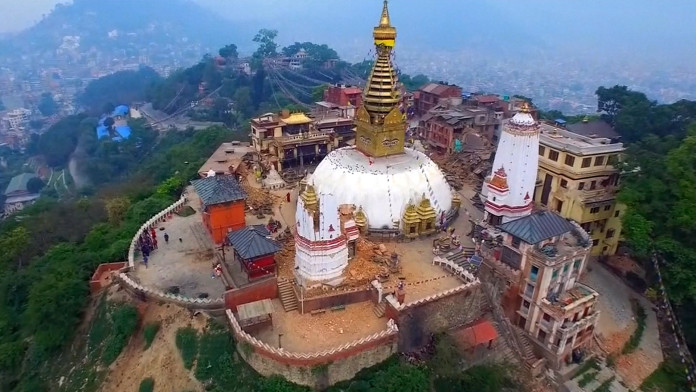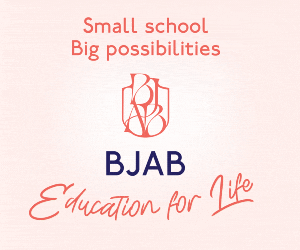Known as a hippy hangout in the 1960’s, Nepal lost its attractiveness as the result of many years of political upheaval. With tourism on the rise again after a period of relative stability, Suzette Reed toured the Himalayan state by motorbike
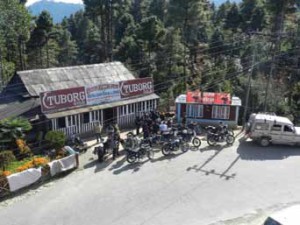 One of my early memories is riding with my dad on his motorbike; bikes remained a feature of my life in my teens and twenties, but two babies dampened my enthusiasm and I rarely rode when the children were small. But when my husband Martin and his biking buddy Dave came up with a plan to go to Nepal, ride bikes and visit temples, I was ready to take to the road again.
One of my early memories is riding with my dad on his motorbike; bikes remained a feature of my life in my teens and twenties, but two babies dampened my enthusiasm and I rarely rode when the children were small. But when my husband Martin and his biking buddy Dave came up with a plan to go to Nepal, ride bikes and visit temples, I was ready to take to the road again.
Bikes are a great way to see Nepal, as public buses are generally crowded, uncomfortable and notoriously unreliable, and hiring a car in Nepal is next to impossible. On a bike you can take in the views, stop along the way and absorb the sights, sounds and tastes of Nepali life. Several tour companies offer ‘biking with backup’ – freedom of the road and local knowledge combined with mechanical and medical support. We became part of a group of 12 riders, aged from 21 to 60, five Brits and seven Spaniards, the adventure beginning with a medical check by the retired English doctor who accompanied us. Wendy had spent the previous six months touring India by motorbike, so had plenty of experience of the roads, the bikes and the bumps and scrapes we were likely to encounter.
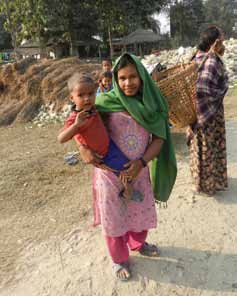 After a day and a half experiencing the chaos, colour and confusion of Kathmandu, acclimatising and doing the tourist sights, taking in the Hindu temples and Buddhist stupas, we headed for the medieval walled town of Bhaktapur to pick up the bikes, Royal Enfield Bullets, traditionally used by the Indian military and police force. They are sturdy, heavy, and sound like an impending thunderstorm.
After a day and a half experiencing the chaos, colour and confusion of Kathmandu, acclimatising and doing the tourist sights, taking in the Hindu temples and Buddhist stupas, we headed for the medieval walled town of Bhaktapur to pick up the bikes, Royal Enfield Bullets, traditionally used by the Indian military and police force. They are sturdy, heavy, and sound like an impending thunderstorm.
“Nepal is said to see itself as an ear of corn caught between the two huge grindstones of India and China”
The first day’s journey took us on a stunning ride along the Nepal/Tibet trade route, known as the Friendship Highway. Huge freight trucks importing Chinese goods hurtled down the mountain side with scant regard for other vehicles, the roads lined with settlements of refugee Tibetan families. The border bridge has a red line painted across the middle to show where Nepal ends, and China/Tibet begins. Nepal is said to see itself as an ear of corn caught between the two huge grindstones of India and China, and on the Friendship Bridge the fragility of a small, impoverished, and vulnerable state was very evident.
TUMBLE
As we gained height, we experienced our first tumble – and guess who was involved? I was riding pillion with Martin and some scree in the road caused the back of the bike to wobble. We were heading for a vertiginous drop and he over-corrected, hitting the front brake, and we slid slowly and gracelessly into a culvert. The bike fell into the ditch, Martin fell onto the handlebars and I fell onto Martin and toppled sideways onto rocks. He had bruised ribs and my left hand was swelling. The bike had smashed wing mirrors and a broken headlight. Martin got back on but I was ushered into the back-up van following us. Wendy thought I might have a fracture so we headed for a clinic.
Within half an hour my hand and wrist were X-rayed on a rather rickety machine, but it was only a sprain. A nurse applied some topical pain relief and bandaged me up. The cost of treatment came to the equivalent of ¤6, and I was sent on my way with my X-rays in a brown envelope. Over the following few days, a few others slid off their bikes but only Dave’s wife Wigs had any lasting damage, a fracture to her foot, which meant she has to ride pillion for the rest of the journey.
JUNGLE
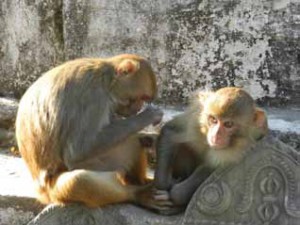 We stayed at the Last Resort, a tourist venue 12 km from the border, perched on the edge of a gorge over the Kosi River, and only accessible by a narrow suspension bridge over the river 160 metres below. We spent two days there in posh safari tents on the terraced forest slopes. For entertainment we were offered a range of extreme sports – bungee jumping, white water rafting, and mountain biking. The bungee jump is one of the highest in the world, and travellers make their way here to prove they are alive by courting death. The Last Resort is good on green credentials, with compost toilets and solar powered showers and sauna.
We stayed at the Last Resort, a tourist venue 12 km from the border, perched on the edge of a gorge over the Kosi River, and only accessible by a narrow suspension bridge over the river 160 metres below. We spent two days there in posh safari tents on the terraced forest slopes. For entertainment we were offered a range of extreme sports – bungee jumping, white water rafting, and mountain biking. The bungee jump is one of the highest in the world, and travellers make their way here to prove they are alive by courting death. The Last Resort is good on green credentials, with compost toilets and solar powered showers and sauna.
The next day was a sweeping ride to Nagarkot for an overnight stop. On a clear day Nagarkot, at 2,175 metres, has fantastic views of the Himalayas. Rising at 5h30, we reached the Chitwan National Park just in time to watch the sun go down. Chitwan means ‘heart of the jungle’ and from here you can ride an elephant into the jungle in the hope of glimpsing something rare and wonderful, which in our case included an Indian one-horned rhinoceros and a gharial crocodile, but sadly no tigers.
After two restorative nights in Chitwan we were back on the road heading for the hill towns of Gorkha, Pokhara and Tansen for few a days of exploration. The traffic was lighter, affording us time to watch black kites soaring on the thermals and see the early morning sun hit the snow on the Annapurna peaks, turning them from white to pearlescent pinks and gold. We stopped in little villages for Nepali tea, a sweet and spicy concoction, and snack on pakoras and samosas for lunch. People came to stare at us. Children arrived first, curious and watchful. They put their hands together in Namaste, the Hindu greeting. Older men were more interested in the bikes and the protective clothing we were wearing.
RIVER TRIP
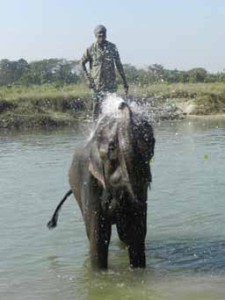 Royal Bardia Wildlife Reserve was our final destination. After an overnight stop, we left the bikes and took to rafts. Gliding down the river, we pulled the rafts up occasionally to trek with local guides into the reserve, where we glimpsed elephants, monkeys and deer, and discovered tiger paw prints on the wet sand. Camping overnight on an island, we were generously fed and entertained by local villagers. Two of our group announced their engagement on the trip; the village priest blessed them and they were given an engagement party they will never forget.
Royal Bardia Wildlife Reserve was our final destination. After an overnight stop, we left the bikes and took to rafts. Gliding down the river, we pulled the rafts up occasionally to trek with local guides into the reserve, where we glimpsed elephants, monkeys and deer, and discovered tiger paw prints on the wet sand. Camping overnight on an island, we were generously fed and entertained by local villagers. Two of our group announced their engagement on the trip; the village priest blessed them and they were given an engagement party they will never forget.
“We were told how to escape dangerous animals”
Our final day was spent trekking through the reserve and we were told how to escape dangerous animals: elephants – run to the river and cross the boulders (as they find it hard to manoeuvre on them); rhino – climb the nearest tree and rise above their eye level; tigers – stand still. They rarely attack humans, but if they do you’ve got no chance.
Fortunately none of these techniques needed to be employed and we returned to our camp having seen lots of wildlife without feeling too threatened.
The next day we flew back to Kathmandu with the interestingly named Yeti Airlines, before leaving for home. As we boarded our homeward plane, I looked up at the night sky to see the moon in almost total eclipse, a magical end to an eventful 15 days.
Blazing Trails Tours £1,999; return flight £647, outbound: Jet Airways (Heathrow-Mumbai-Kathmandu); inbound: Gulf Air (Kathmandu-Bahrain-Heathrow) www.blazingtrailstours.com


